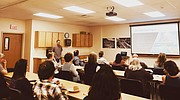Chamber luncheon gets serious history lesson
KELLOGG — Last week Andy Helkey with the Panhandle Health District gave a detailed and insightful look at the Bunker Hill Superfund Project during the Historic Silver Valley Chamber of Commerce’s annual monthly luncheon.
Helkey’s detailed presentation covered everything from the heights of Bunker Hill’s success to its decline and demise in the late ’70s and early ’80s.
“History is one of my favorite topics and the unique history of the Silver Valley is one of the things that attracted me to the area,” Helkey said.
Covering the many decades of financial success, he discussed how Bunker Hill became one of the United States’ highest-producing mines.
It was when Helkey got to the topic of the Baghouse Fire of 1973, that folks really understood the gravity of the company’s depravity.
The specifics of that fire are really the ground zero for the pollution in the area.
The baghouse was essentially a giant filter within the iconic smoke stacks that caught the bulk of the pollutants as it was carried into the air.
In September 1973, fire broke out and burnt through the smelter’s primary pollution control and the company made the decision to not replace the destroyed filters and continued operating the smelter anyway.
Particulate emissions went from 10-20 tons per month up to 160 tons per month, containing 50-70 percent lead.
The audience was stunned listening to Helkey’s description of the damage and pollution, but then were pleased to hear how the ongoing remedy work has removed a vast amount of that pollution.
Helkey has given presentations like this multiple times and each time he really strives to drive home just how much work has gone into rehabilitating the area.
“The main thing I want people to take away from the presentation is how much work we have put into our communities and the potential they have,” Helkey said. “Understanding the history of the Superfund site is important so that people know where they may still encounter contaminants and how they can protect themselves.”
While most people in attendance knew most of the story of the Bunker Hill Superfund Site, Helkey’s presentation offered new information and more thoroughly expounded upon facts for the people in attendance.
For more information on the Bunker Hill Superfund Site and its cleanup programs and projects, contact the Panhandle Health District at 208-786-7474.



